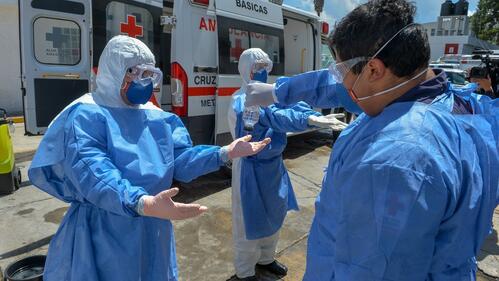Epidemics and pandemics
Epidemics are an unexpected, often sudden, increase of a specific illness within a community or region. Pandemics are when an epidemic occurs worldwide, crossing international borders and affecting a large number of people. A number of communicable diseases can be significant health threats at the local, regional and global level and lead to epidemics or pandemics. Epidemics and pandemics can be prevented and mitigated through a range of household and community measures, such as good hygiene, social distancing and vaccination.

Emergency appeals
Zambia: Cholera Outbreak
Zambia: Cholera Outbreak
Zimbabwe: Cholera Outbreak
Zimbabwe: Cholera Outbreak
Nigeria: Diphtheria outbreak
Nigeria: Diphtheria outbreak
Equatorial Guinea: Marburg virus disease
Equatorial Guinea: Marburg virus disease
Do you know how to prepare for an epidemic or pandemic?
Assess and plan
Be aware that epidemic and pandemic threats and transmission can occur through air, water, food, vectors (organisms, such as mosquitoes or ticks) and/or the exchange of bodily fluids. Stay informed on these threats through your local and national health authorities. Protect water sources, follow good hygiene and sanitation, and vaccinate children to keep them safe. Notify the authorities immediately if you notice any unusual incidences of sickness in people or animals.
Reduce risks
Safe drinking water is the most important prevention measure for many diseases—keep water clean with safe water storage and purification practices. Practise good personal hygiene and sanitation—including learning how to wash your hands properly with soap and clean water. Keep food clean and dispose of human and animal waste safely. Follow social distancing guidelines and other advice from health authorities in your country.
Prepare to respond
Use personal protective equipment (PPE), such as facemasks, when caring for sick people and when advised to by health authorities. Clean and disinfect surfaces in your home. Prepare emergency supplies—such as food, essential medicines and hygiene items—if there is a chance you will need to isolate in your home for an extended period. Learn how to recognize symptoms and seek medical attention for anyone who cannot be treated at home.
General do's and don'ts
Additional do's and don'ts
Advice on how to protect yourself during an epidemic or pandemic can differ depending on how a disease is transmitted (spread):
- Airborne diseases: transmitted through the air via small droplets that a person breathes in or that land on other people or surfaces
- Blood or body fluid borne diseases: spread through contaminated blood or bodily fluids
- Zoonotic diseases: diseases that spread from animals to humans
- Vector-borne diseases: diseases spread by living organisms (such as mosquitoes and ticks), often by bites
- Food-borne diseases: caused by eating food contaminated with bacteria, viruses, parasites or chemical substances
You can find more specific do's and don'ts for each of these types of disease in the below Pandemics and epidemics: Key Messages document.
